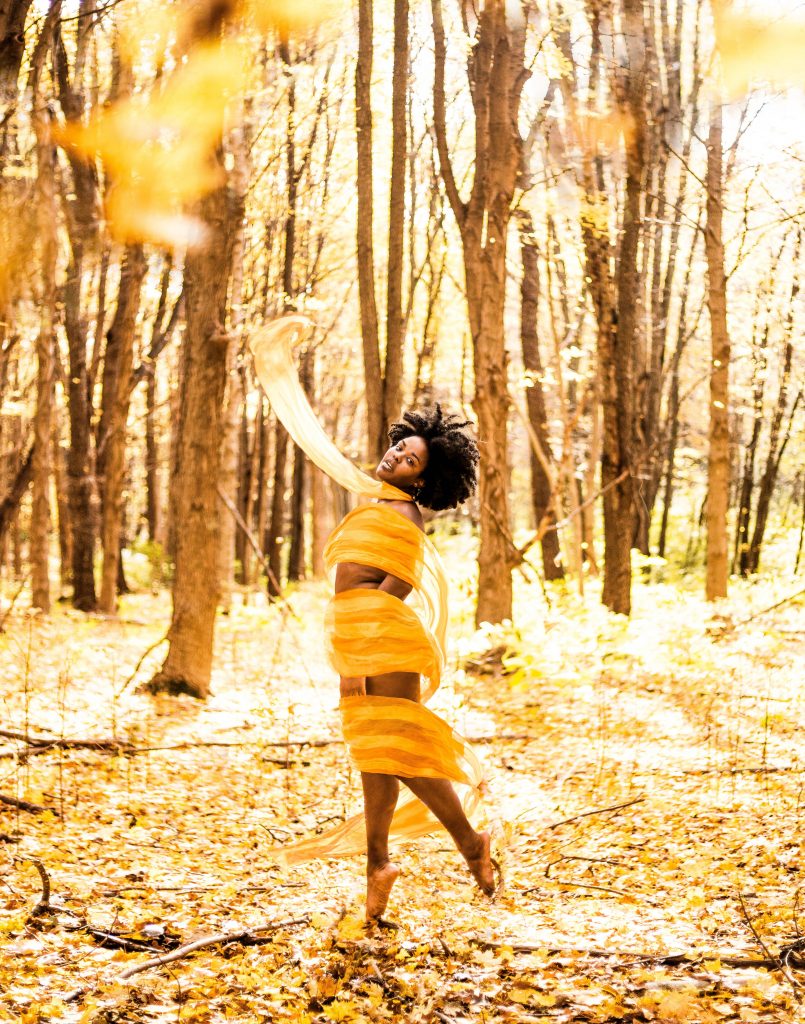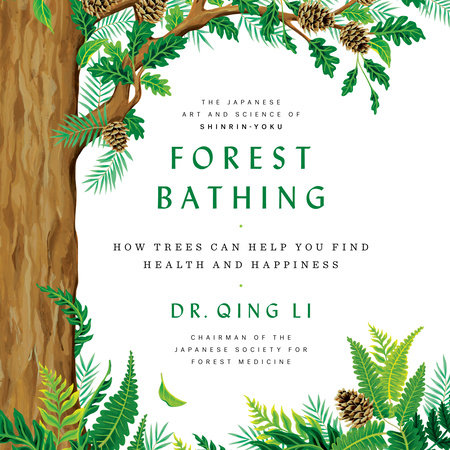A Forest Bath is What the Doctor Ordered
The seeds that led Tasha Harris and Alexandra Lowry to become forest therapy guides were planted when both women were children.
And now, they guide people in Massachusetts and Connecticut, respectively, in unearthing those seeds within themselves through shinrin-yoku. It is a Japanese practice that in English translates to forest bathing, and Lowry said it is starting to take off the way yoga did a decade ago.
Forest bathing is the practice of deliberately connecting with nature through all five of your senses — sight, sound, touch, smell, and taste. The practice allows you to be bathed in phytoncides — the substances emitted from trees and other plants.
It also allows you to breathe in the soil of the forest floor, which contains a common bacteria called Mycobacterium vaccae. Researchers have found that exposure to both can increase your happiness quotient, lower blood pressure and feelings of stress and anxiety, and boost your immune system — all things that probably feel especially necessary during a global pandemic.
Lowry is the owner and a certified life coach for The Wisdom Alliance. She said she learned about forest bathing five or six years ago through her own then-burgeoning curiosity about the nature and biology of trees. She’d taken to walking a trail near her home during a tumultuous time in her life. And she wanted to know more about why, after time spent walking the forest floor she felt lighter, calmer — feelings that she most associated with her childhood.

“I wanted to know what it was about trees that I was so fiercely connected to since I was a little child who had actually talked to and named trees,” Lowry said. “At the time I was so disconnected from nature, so out of sorts, that I had forgotten this history.”
That trail that Lowery walked several days a week would lead her past a building that belonged to the Connecticut Forest and Park Association. Her research had led her to learn about forest bathing; her life coaching skills led her to ask the association about how she could marry these two passions for the benefit of others. And that’s how she became a certified forest therapy guide and has been leading forest baths for about five years.
Harris’ journey to becoming a forest therapy guide was equally serendipitous.
Growing up in the Roxbury neighborhood of Boston, Harris developed her life long love affair with the great outdoors early and maintained the connection well into adulthood. And it was all thanks to summers spent two weeks at a time from age 8 to 14 at a Fresh Air Fund-style camp in Western Massachusetts. She would go on to help run the camp as a section leader and later as one of the overnight camp directors well into her 30s.
“There was a pond, a lake, trees, cabins and kids,” Harris recalled. “I think back then I took the trees for granted. But it was the safest place to be a kid.”

Harris is now a kindergarten teacher at a charter school in Dorchester, Mass., where connecting to nature is an integral part of the curriculum. She learned about forest bathing while watching a local news program two years ago. Interestingly, she said her sister texted her that she should watch the show after Harris had already seen it.
“That was confirmation,” she said.
Harris ultimately found a training program that took her to Costa Rica. Her school even helped her defray the cost of the training. And she’s now using her skills to help the school transform a nearby piece of land into a healing micro forest.
Forest Bathing Basics
While you don’t need a forest therapy guide to forest bathe, they can be helpful particularly for first-timers who don’t know where to start, or for those who want to deepen their practice. One thing you should know: forest bathing and hiking aren’t synonymous, though their benefits can be.
Forest bathing is characterized by a slow deliberateness where the only goal — if there is one beyond simply being with nature — is to engage nature with all five of your senses. Given enough time — two hours is the usual recommended dose — a person can tap into a sixth sense, a feeling of euphoric well-being and awareness that can flood your body with feel-good endorphins.
“Basically it’s slow, meditative walking in the woods,” Lowry said. “I tell them there is no right and wrong. It’s detaching from technology. We don’t put in earbuds. You immerse yourself in a sensory bath.”
Lowry said she teaches people about their senses and why it’s important to connect with them. She said breathing in the smells of a forest is a direct way to connect with the pathways of the brain. Scents are also most closely related to memory and emotion. To tap into that, Lowry said she might do something like using a stick to scratch the dirt of the forest floor and hold it up for everyone to take a whiff.
Harris, who owns Center Time Retreats, does her guiding in some of the local parks that she frequented as a child and a tour usually takes about three hours. She said people are often caught off guard when she explains what forest bathing isn’t and why it takes so long.
“I say we’re not going to go hiking today,” she said. “We’re not having a naturalist talk, not exercising, not going to be talking to each other. We’re going to move forever slow, and more so, that at every step we’re going to notice a lot of things.”
Harris said that the experience of forest bathing assaults your senses in the best possible way.
“It’s a good sensory overload,” she said. “It forces your body into this hyper state of being in the present moment.”

Harris said those with outdoor experience are usually familiar with the pace and destination-mindset of hiking. But with forest bathing, a guide can help you understand that simply being in the forest means you’ve already arrived at your destination. All you have to do upon arrival is soak it all in.
“The destination is wherever you are,” she said. “We’re not going to the summit. We’re where we are and I think that’s the key difference and why [forest bathing] is somewhat magical.”
Miracles Abound
Lowry said she’s witnessed the kind of magic Harris has seen. It happened for a woman who’d come for a forest bath with her husband after meeting Lowry at a corporate event where Lowry was the speaker.
After the forest bath, the woman wrote to tell her that she’d lost her father in an accident that happened in the family’s backyard. He was burning leaves by the forest. The fire got out of control and he was burned to death.
“It was just a horrific thing to have happen and she was so traumatized by it,” Lowry said. “She was also having real issues in her marriage as well. [The couple] spent a lot of time at the end of the hike together in a special patch of a plantation forest that is very stunning.”
Lowry said she could tell something was going on with the couple, but knew not to pry. The note from the woman went on to say that the forest bathing experience helped here heal her forest-related trauma. It also helped her start to heal her relationship with her husband.
“You just don’t know what people are dealing with,” she said. “I see people visibly change. Their step is lighter, their shoulders are softer, their faces are softer, and there is a brightness and a lightness and there’s a lot of scientific research that shows that literally these chemicals emitted from trees heal us not just spiritually but biologically.”
Harris said she sees similar transformations, particularly in children. Her school has a garden where students get to connect to the earth. Students also go to the local arboretum for nature walks. Harris has been able to do that in tandem with an art teacher who gives the students drawing prompts. Harris said she often invites her students to find what is known in forest bathing as a “sit-spot,” where they go find a seat in nature for 20 minutes.
“I tell them I know they’ve found their sit-spot when they are sitting still, or standing comfortably and their body looks relaxed,” she said. “That is so powerful. Nature looks good on all of them.”
Given enough time, a person can tap into a sixth sense, a feeling of euphoric well-being and awareness that can flood your body with feel-good endorphins.
Given enough time, a person can tap into a sixth sense, a feeling of euphoric well-being and awareness that can flood your body with feel-good endorphins. She said the hyperactivity that some children display in a classroom — that even is typically treated with medication — can disappear outside. To her, that suggests it’s not their attention that is deficient but their access to nature.
“There is such a difference between watching children learn outside and watching a marked improvement in behavior,” Harris said. “They have greater resilience and efficacy in their ability to learn. When we get back to school, there are no problems. They’re mellow and chill, we have snacks and they go home happy.”
Ready to forest bathe but…
Forest bathing is billed as an ideal practice for anyone regardless of their physical ability. The slowed-down nature of it means you don’t have to be in amazing physical shape or even walk to do it.
In fact, Dr. Qing Li, the chairman of the Japanese Society for Forest Medicine and the author of Forest Bathing: How Trees Can Help You Find Health and Happiness, suggests that you don’t even need a forest. A locally accessible park, or even a yard, will do. That’s good news for us urban dwellers.

But as Lowry pointed out, not everyone has a positive experience or memory with the forest. For some people, the forest represents trauma. And for Black people and people of color, in particular, that trauma can be racialized and historic.
“It’s bittersweet because it’s hidden in plain sight,” Harris said. “There are realistic invisible barriers we face as [Black Indigenous People of Color].”
Thomas Easley, the first dean of community and inclusion at Yale University’s School of Forestry and Environmental Studies, said talk of connecting deeply to nature can feel disjointed for people whose ancestors were forced to labor outdoors for no pay, had their land stolen, and lived under laws that legislated where they could and couldn’t be.
“It’s hard to care about bathing in the forest when your grandfather was afraid to walk in it — when you’re trying not to be afraid in it,” he said.
Easley, who marries the art form of rap and the culture of hip hop music as a bridge to connect communities of color to forestry, said that to interest such communities in the benefits of the outdoors, you can’t sell them on it. They have to come to it on their own. And that is helped by seeing people they identify with engaged in the activity who can help them see what’s in it for them.
Harris said she incorporates an acknowledgment of that trauma at some point during a forest bathing session though it is not something on which she dwells. She also makes a point to create a safe space by attending to people’s fear, answering their questions, and reminding them that there is safety in numbers.
“It’s about taking care of people and helping them heal,” she said. “But we cannot ignore the trauma; we can’t not talk about strange fruit. I acknowledge that we have real trauma with trees.”
TAKE ACTION: For the self-starter: Read Forest Bathing: How Trees Can Help You Find Health and Happiness by Dr. Qing Li
Need a guide? Check out the Association of Nature and Forest Therapy Guides and Programs
BIPOC? Forest Therapy Guide Tasha Harris encourages you to connect with elders in your family or community who have a connection to farming and gardening and to spend time talking to them about their connection to the earth through growing things.


